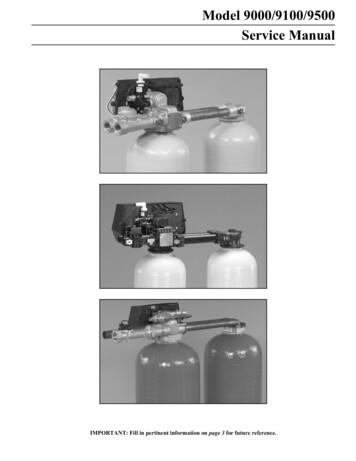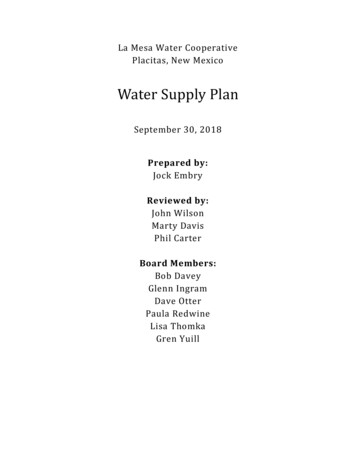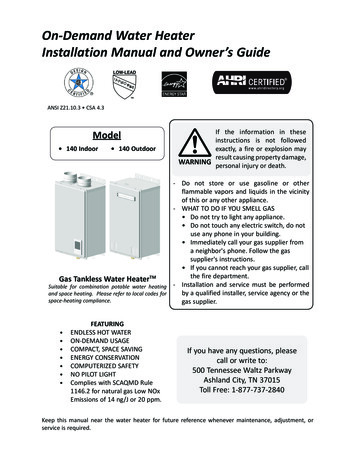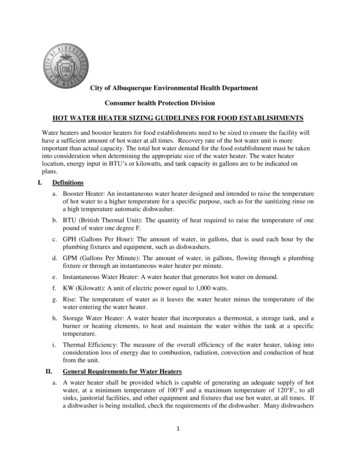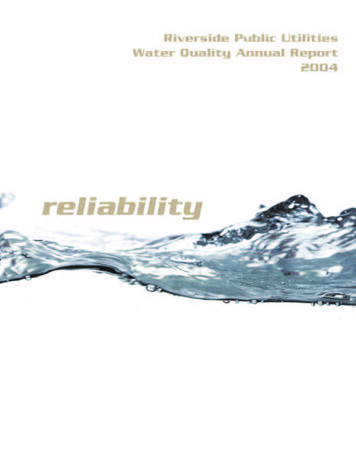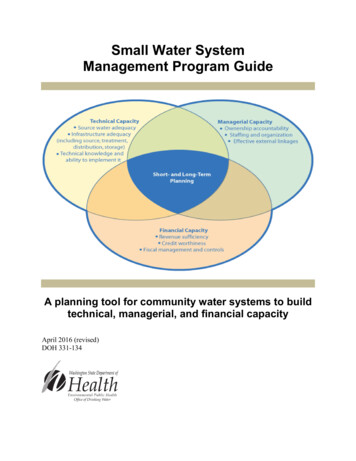
Transcription
Small Water SystemManagement Program GuideA planning tool for community water systems to buildtechnical, managerial, and financial capacityApril 2016 (revised)DOH 331-134
Table of ContentsSecuring Your Water System’s Future . iUsing this Document . iiOur Perspective on Planning .iiiPlanning Expectations . iiiTechnical Assistance . vThe time to repair a roofis when the sun is shining.-President John F. KennedyManagerial Chapter Overview . viTechnical Chapter Overview . viiFinancial Chapter Overview . viiiChapter 1: Managerial . 11.1 Management Structure and the Governing Board.31.2 Service Area and Facilities Map .61.3 Service Policies.81.4 Cross-Connection Control Program. 101.5 Source Water Protection Program . 161.6 Emergency Response Plan . 211.7 Next Steps to Improve Managerial Capacity . 27Chapter 2: Technical . 282.1 Certified Operator . 292.2 Operations and Maintenance Program . 312.3 Water Quality Monitoring Program . 362.4 Component Inventory and Assessment . 412.5 Water Rights Self-Assessment. 462.6 Water Production . 502.7 Current Water Consumption . 532.8 Future Water Consumption . 552.9 Water Use Efficiency Program . 582.10 Next Steps to Improve Technical Capacity . 65Chapter 3: Financial . 663.1 Short-Lived Asset Replacement and Other Planned Improvements . 673.2 Long-Lived Asset Replacement. 703.3 Six-Year Budget . 723.4 Water Rates. 753.5 Next Steps to Improve Financial Capacity . 76Chapter 4: Other Documents . 774.1 Water Facilities Inventory Form . 784.2 Annual Operating Permit . 794.3 Consumer Confidence Report (Optional) . 814.4 Other System Records (Optional) . 82
SWSMP TablesTable 1-1 Ownership and Management . 3Table 1-2 Service Area and Facilities Map. 7Table 1-3 Service Policies . 9Table 1-4 Cross-Connection Control Program . 14Table 1-5 Source Water Protection Program . 19Table 1-6 Emergency Response Plan. 22Table 2-1 Certified Operator . 30Table 2-2 Operations and Maintenance Program. 32Table 2-3 Water Quality Monitoring Program. 39Table 2-4A Short-Lived Asset Component Inventory and Assessment(service life is 6 years or less) . 43Table 2-4B Long-Lived Asset Component Inventory and Assessment(service life is longer than 10 years) . 44Table 2-5A Water Rights Self Assessment Existing Status . 48Table 2-5B Water Rights Self Assessment 6 Year Forecast . 49Table 2-6 Water Production, Consumption, and Distribution Leakage (DSL). 52Table 2-8 Future Water Consumption . 56Table 2-9 Water Use Efficiency Program . 63Table 3-1A Planned Improvements (short-lived assets) . 67Table 3-1B Planned Improvements (short-lived asset reserve) . 69Table 3-2 Planned Improvements (long-lived assets) . 71Table 3-3 Budget Table . 74Table 4-2 Annual Operating Permit . 80Excel SpreadsheetsTable 2-6: mp2-6.xlsTable 3-1B: http://www.doh.wa.gov/ portals/1/documents/4200/swsmp3-1B.xlsTable 3-3: mp3-3.xls
Securing Your Water System’s FutureIf you are the owner, governing board member, oroperator of a small community water system, thisguidebook is for you. It will lead you to the knowledge,skills, and resources you need to ensure your watersystem continues to meet its obligations to yourcommunity. If you haven’t engaged in a structuredprocess to develop and implement a planning tool toprepare your water system for the challenges of today andtomorrow, now is the time to start.“There is in the act ofpreparing, the momentyou start caring.”-Winston ChurchillThis guidebook will direct you to collect information, assess it, and determine the type and levelof action needed to secure your system’s future. If you’ve done some of this work already, it willchallenge you to revisit your past work, update it as needed, and maintain it in one place so thenext generation of board members and operators can carry on your legacy of service.While preparing this technical, managerial, and financial planning document, be sure to involvegoverning board members, current and previous operators, administrative assistants, accountants,vendors, contractors, and consumer representatives. It’s a big job to organize and harness thetalent and energy of all these people. But, don’t turn away from the task; it’s too important. Yourcommunity’s economic wellbeing and the health of its members depend on the water systemfunctioning properly—from the pumps and pipes that deliver the water, to its managementstructure, and the financial capacity that make it all possible.Small Water System Management Program Guide (331-134)April 2016-i-
Using this DocumentWe divided this guidebook into three chapters:managerial, technical, and financial. These terms describethe main attributes of successful water system operations.There is nothing magical about how we assigned thecontent within the sections. The attributes are interrelatedand interdependent.“By failing to prepare,you are preparing to fail.”-Benjamin FranklinEach chapter includes a section called “Next Steps.” You can use these sections to keep track ofunaddressed items and future actions you want to take to improve your system. If your latestsanitary survey identified items to correct, include those items in your list of next steps. Ourgoal is to help you develop a living document to govern the managerial, technical, andfinancial aspects of your water system.Try to develop each section with input from your system’s governing board and operators. Invitecommunity members to contribute to this effort by allowing them to share their views on theappropriate level of water system planning, desired level of infrastructure reliability (such asmaintaining pressures above required minimums, frequency of outages, or taste and odorcontrol), and how to allocate the cost of service to customers (including future improvements).This guidance is general, but the content you add should reflect your system’s specificcircumstances. Each section is a required element unless it says it is optional. Think about howyou’ll use this document before you begin. It should hold the basic information shown in theTable of Contents. But, decide whether you also want it to serve as a: Operations manual.File for operating records, sampling results, reports, correspondence, and engineeringdesigns.Placeholder for policies and governing ordinances or by-laws.Record of the governing board and operator’s duties and responsibilities.Institutional memory of the water system.Your decisions will determine how you build this document, where you keep it, how youmaintain it, and who needs a copy to do their job.This document contains tables and links to Excel spreadsheets. The steps in each section explainhow to use them. Some of the tables include check boxes.You can fill-in the check boxes by double clicking on the box and selecting “Checked” as thedefault value.Small Water System Management Program Guide (331-134)April 2016-ii-
Our Perspective on PlanningThe Department of Health (Agency) is committed to appropriate planning by all water systems.Here’s why:1. Safe and reliable drinking water doesn’t happen by itself. Dedicated people committed toappropriate system planning, design, operation, and management make it happen.2. Many small system governing board members receive little or no compensation for their timeand oversight. The members often don’t fully understand their proper role and responsibilityfor providing safe and reliable drinking water when they take on these duties.3. Many small system operators have responsibilities that extend beyond the water system.They often have limited time and resources to do the job that needs to be done.4. People who govern or operate small community water systems have giant responsibilities.a. Safe drinking water is a 24/7 activity. Serious illness may result from a singleunanticipated event in the system.b. Economic considerations. The value of a community’s homes and businesses isconnected to the safety and reliability of the water system that serves them.c. High expectations. Water system customers have expectations as high as those theyplace on phone and electric power utilities.d. Serious legal obligations. There are serious legal and financial liabilities associated withowning and operating a public water system.5. Small systems face tremendous financial pressures because they spread their costs acrossfewer customers. This means each regulation and new task imposes a disproportionately highcost to each customer.6. Nothing lasts forever. Eventually, you will need to replace every single part of your watersystem. Managerial and technical planning tools will not help if the infrastructure is failing.This guide emphasizes the importance of evaluating your short-lived and long-lived assets toprioritize their replacement and to begin planning now how you will pay for it.Planning ExpectationsAll water operators should do the appropriate level of planning for their systems. System ownersand operators should work together in such an important effort. The guidebook will help youdevelop a Small Water System Management Program (SWSMP). The SWSMP is the planningdocument described in WAC 246-290-105. The other planning document is a comprehensivewater system plan (WSP) described in WAC 246-290-100. All community water systems that arenot required to complete a WSP must develop and implement a SWSMP.Small Water System Management Program Guide (331-134)April 2016-iii-
A SWSMP is for community water systems that are not “expanding.” It’s the right document ifyou are restricting service to your existing service area and you are not going to construct newinfrastructure (such as a well or reservoir) to increase your system’s capacity to serve moreconnections than it is currently approved to serve. See your Water Facilities Inventory (WFI) forthe number of approved connections.If you plan to expand your service area or construct new infrastructure to grow your number ofapproved connections, call your regional office and speak with the regional planner for yourcounty. You may need to submit other planning or engineering documents.You do not need to hire a professional engineer to complete this SWSMP. You may choose to doso, but it is not required.We may require you to submit your SWSMP for our review and approval for any of thefollowing reasons: Significant non-compliance with drinking water regulationsSignificant operational, technical, managerial, or financial problemsObtaining approval of your water system, if it’s never been approved (if your operatingpermit is BLUE, it’s possible that your system was never approved)Satisfying a condition for a Drinking Water State Revolving Fund (DWSRF) applicationSubmitting your SWSMP for Agency approval. Take note of the following if you intend tosubmit your SWSMP for approval:1. Contact your regional office to request a “preplan meeting” with our regionalplanning and engineering staff. This is your opportunity to discuss the focus of yourSWSMP. You must address each required section, but we can work with you todetermine the scope and level of detail depending on your system’s needs and uniquecircumstances.2. You must include a Small Water System Management Program Submittal Form (331396).3. You must submit at least two copies. Ask your regional planner how many printedcopies you need to submit. In most cases, we will forward one copy to the Department ofEcology. We encourage you to include an electronic copy with the printed version, butthis is not required.Small Water System Management Program Guide (331-134)April 2016-iv-
Technical AssistanceThird Party Technical Assistance ProvidersRural Community Assistance CorporationEvergreen Rural Water of Washington1403 South Grand Blvd, Suite 203 S.Spokane, WA .O. Box 2300Shelton, WA 98584360-462-9287http://www.erwow.org/Washington State Department of Health Office of Drinking /DrinkingWater.aspxHeadquartersTown Center 3(243 Israel Road SE, Tumwater)P.O. Box 47822Olympia, WA 98504-7822360-236-3100 or 800-521-0323Northwest Regional Office20435 72nd Ave. S., Suite 200Kent, WA 98032253-395-6750(Island, King, Pierce, San Juan, Skagit, Snohomish andWhatcom counties)Eastern Regional Office16201 E Indiana Ave, Suite 1500Spokane Valley, WA 99216509-329-2100(Adams, Asotin, Benton, Chelan, Columbia,Douglas, Ferry, Franklin, Garfield, Grant, Kittitas,Klickitat, Lincoln, Okanogan, Pend Oreille,Spokane, Stevens, Walla Walla, Whitman andYakima counties)Southwest Regional OfficeTown Center 3( 243 Israel Road SE, Tumwater)P.O. Box 47823Olympia, WA 98504-7823360-236-3030(Clallam, Cowlitz, Clark, Grays Harbor, Jefferson,Kitsap, Lewis, Mason, Pacific, Skamania, Thurston andWahkiakum counties)We designed this guidebook with internet access in mindThis guidebook is available in electronic format only. You can download it or request a copy inCD format at the publications link below.Our publications are online at lications.cfmOur forms are online inkingWater/PublicationsandForms/Forms.aspxFor people with disabilities, this document is available on request in other formats. To submit a request,please call 1-800-525-0127 (TDD/TTY call 711).Small Water System Management Program Guide (331-134)April 2016-v-
Managerial Chapter OverviewManagerial capacity refers to the ability of the systemdecision makers to conduct necessary activities suchas staffing, planning, maintaining accountability, andinteracting with customers and regulatory agencies.“Planning without action is futile,action without planning is fatal.”Your Mission Statement-UnknownWe encourage you to place your system’s mission statement at the start of this section. If youdon’t have a mission statement, take the time to develop one by involving a cross-section of yourwater system staff and your community. Your mission statement shouldn’t be complicated, just aclear statement that explains why your organization exists and its values.Here are some examples: To provide our community with quality water and great customer service.To provide a safe and reliable drinking water supply to our customers.To provide a high quality water supply that meets current and future customer needs.To provide an adequate and reliable water supply of desired quality—now and for futuregenerations—in a manner that incorporates economic growth, environmental protection,and social development.Formal AdoptionWe encourage you to have your governing body formally adopt your SWSMP after it’scompleted. This extra step clarifies your intent to use your SWSMP and signals the importanceof delivering safe and reliable drinking water to your community.Management ElementsThe managerial chapter addresses the following topics: Each section includes its purpose,background, specific instructions or guidance, ideas for further action, and links to additionalresources. Some sections provide a template that meets minimum requirements. Management structure and the governing boardService area and facilities mapService policiesCross-connection control programSource water protection programEmergency response planEach section includes a purpose, background, specific instructions or guidance, ideas for furtheraction, and links to additional resources. Some sections provide a template that meets minimumrequirements.Small Water System Management Program Guide (331-134)April 2016-vi-
Technical Chapter OverviewTechnical capacity refers to the physical system,including source, treatment, storage, anddistribution plus the ability of personnel tooperate the system adequately.“Even if you’re on the right track,you’ll get run over if you just sit there.”Technical Elements-Will RogersThe technical chapter addresses the following topics: Certified operatorOperation and maintenance programWater quality monitoring programComponent inventory and assessmentWater rights self-assessmentWater productionCurrent water consumptionFuture water consumptionWater use efficiency programEach section includes a purpose, background, specific instructions or guidance, ideas for furtheraction, and links to additional resources. Some sections provide a template that meets minimumrequirements.This chapter offers an optional Excel spreadsheet to help you calculate your water production,consumption, and distribution system leakage.Small Water System Management Program Guide (331-134)April 2016-vii-
Financial Chapter OverviewFinancial capacity refers to the system’s ability togenerate sufficient revenue, maintain credit worthiness,and manage funds through budgeting, accounting, andother methods of fiscal control.“One step at a time is goodwalking.”A Looming Crisis-Chinese ProverbEPA recently estimated that, over the next 20 years, our state will need 2.4 billion for structuralimprovements to community water systems with fewer than 1,000 connections. This representsan average of 1.2 million per system to replace and repair system infrastructure.The Funding SqueezeLoan and grant funding is extremely competitive. Local, state, and federal budget deficits arecreating a higher demand for these funds, while the pool of available funds is shrinking. It iscommon for our state revolving loan fund program to receive applications requesting five timesmore money than we have available to loan.Every funding agency (public or private) will expect a complete financial picture of yourorganization. Funding agencies will not grant or loan money on favorable terms to a watersystem that cannot tell its complete financial story.If you intend to obtain financing to maintain and improve your system, start planning now! Youwill need to show what your true cost of service is, how you allocate the cost to your customersthrough rates and fees, how successful you are at collecting rates and fees, and where the moneyis actually spent. Commit to operating your system like a business enterprise.The bottom line is that your total annual revenues must cover your total annual operatingexpenses, debt payments, taxes, fees, and budgeted payments into reserve accounts. Watersystems should have dedicated reserve accounts for an operating cash reserve, emergencyreserve, and short-lived and long-lived asset replacement reserves. This guidebook provides thebasic building blocks for creating the right budget for your system’s short- and long-term needs.Financial ElementsThe financial chapter addresses the following topics: Short-lived asset replacement and other planned improvementsLong-lived asset replacementSix-year budgetWater ratesEach section includes a purpose, background, specific instructions or guidance, ideas for furtheraction, and links to additional resources.This chapter offers two optional Excel spreadsheets to help you create a complete budget.Small Water System Management Program Guide (331-134)April 2016-viii-
Dead bird inside reservoir overflowMouse nest over wellheadHow often do you check thevent and hatch on your reservoir?Are your wells secure from contamination?Public water supply next to farm pondAre your treatment processes up to the taskof ensuring safe water every day?Small Water System Management Program Guide (331-134)April 2016-ix-
Are you in a position to respondin an emergency?How effective is your cross-connectioncontrol program?Is your water supply vulnerableto severe drought?How will you finance replacementof your pipelines?How should you prepare for this?Small Water System Management Program Guide (331-134)April 2016-x-
Small Water System Management Program(Name of Water System)(Water System ID#)(Date)(Your Logo)Small Water System Management Program Guide (331-134)April 2016-xi-
Chapter 1: ManagerialManagerial capacity refers to the ability of system decision makers to conduct activities such asstaffing, planning, maintaining accountability, and interacting with customers and regulatoryagencies.What is sufficient managerial capacity?OwnershipAccountability Owners, governing board members, and managers have clearly identifiedresponsibilities. These individuals are accountable for the management ofthe system. Governing board members and managers are actively involved in capitalimprovement and financial planning to meet the short- and long-termneeds of the system. They develop and periodically revisit strategicplans, including source water protection and emergency preparedness.Staff Knowledgeand Training System staff have necessary licenses and certifications and adequateknowledge to manage operations and understand regulatoryrequirements. System staff receive ongoing training to stay current on new regulatoryrequirements and best practices.EffectiveExternal Linkages Governing board members, managers, and system staff interact with theircustomers and with regulatory agencies. Governing board members, managers, and system staff buildrelationships with customers, technical assistance providers, andregulatory agencies to increase their ability to solve problems quickly.Small Water System Management Program Guide (331-134)April 2016-1-
Mission Statement (Optional)Insert your mission statement.Statement of Adoption (Optional)Describe how and when your governing board adopted (or will adopt) this document.Governing Board Members (Optional)List the names and titles of current governing board members.Small Water System Management Program Guide (331-134)April 2016-2-
1.1 Management Structure and the Governing BoardPurposeTo document the system’s management and ownership structure.BackgroundA water system’s governing body is legally obligated to deliver safe drinking water to itscustomers. Such a responsibility must not be taken lightly. System decision makers play asimportant a role in delivering safe drinking water as system operators do because they set thesystem’s priorities and policies. It is important to document who makes decisions and how theymake them, and communicate this information to system staff and customers.How to complete this sectionAnswer the questions in Table 1-1 on how your system is owned and managed and howdecisions are made. Your sanitary surveyor may go over these answers during your sanitarysurvey.Some questions ask you to attach copies of relevant documents. This will keep importantinformation in one place. You can attach copies in this section, in Chapter 4 (Other Documents),or add a reference to explain where they are.Table 1-1Ownership and ManagementWater system nameType of systemCheck all that apply.Homeowners associationSingle private ownerPartnershipsCorporationLocal government(Town*, County*, Public Utility or Water District)Other*If your system is a town or county, ask your regional planner if a SWSMPis the right planning document for you.Name and phone number forperson(s) or association thatowns systemDo you have articles ofincorporation or a certificate ofregistration with the Departmentof Revenue?NamePhoneNamePhoneYes. If yes, attach a copyNo.Small Water System Management Program Guide (331-134)April 2016-3-
Do you have a document thatestablishes the legal authority tomake decisions for the system?Yes. If yes, attach a copy.Do you have any insurancepolicies for the system?Yes.For example, by-laws, resolutions,ordinances?NoNo.Who makes the major decisions?For example, who decides when to makeimprovements, how to financeimprovements, when to allow additionalconnections.Single partyBoard(how many members)System customers or a representative subset of customersCommissioners(how many commissioners)OtherHow long are the terms of servicefor members of the decisionmaking body?How often do those responsiblefor making decisions meet?MonthlyWhen necessaryAnnuallyQuarterlyOtherAre customers notified aboutthese meetings?YesNoIf yes, how are
develop a Small Water System Management Program (SWSMP). The SWSMP is the planning document described in WAC 246-290-105. The other planning document is a comprehensive water system plan (WSP) described in WAC 246-290-100. All community water systems that are not required to complete a WSP must develop and implement a SWSMP.





